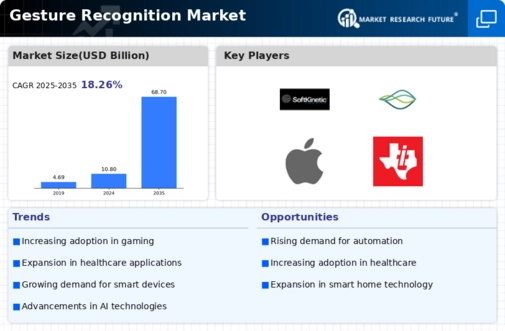Top Industry Leaders in the Gesture Recognition Market

Gesture Recognition Market: A Competitive Landscape
The global gesture recognition market is poised for significant growth, driven by advancements in technology and increasing demand across various industries. This dynamic landscape presents both opportunities and challenges for established players and new entrants.
Key Players:
- Infineon Technologies AG (Germany)
- Qualcomm Incorporated (U.S.)
- SoftKinetic Inc. (Belgium)
- Iris Guard (U.K.)
- Apple Inc. (U.S.)
- Omron Corporation (Japan)
- Texas Instruments (U.S.)
- Intel Corporation (U.S.)
- Microsoft Corporation (U.S.
Strategies Adopted:
To stay ahead of the competition, key players are adopting various strategies, including:
- Technological Innovation: Investing in research and development to create more accurate, robust, and efficient gesture recognition algorithms and hardware.
- Partnerships and Collaborations: Collaborating with other technology companies, research institutions, and industry leaders to leverage expertise and develop new applications for gesture recognition.
- Vertical Market Focus: Focusing on specific industries such as healthcare, automotive, and consumer electronics to tailor solutions to address their unique needs.
- M&A Activity: Engaging in mergers and acquisitions to acquire talent, technology, and market share.
Factors for Market Share Analysis:
Several factors can be considered when analyzing market share in the gesture recognition market, including:
- Product Portfolio: The breadth and depth of a company's product portfolio, catering to various applications and device types.
- Technological Expertise: The level of expertise in developing and implementing advanced gesture recognition algorithms and hardware.
- Market Penetration: The reach of a company's products in various industries and geographical markets.
- Brand Recognition and Reputation: The brand awareness and reputation of a company within the industry and among consumers.
- Financial Performance: The financial health and stability of a company, including its revenue, profitability, and market capitalization.
New and Emerging Companies:
Several new and emerging companies are entering the gesture recognition market with innovative solutions and competitive pricing. These companies are focusing on specific niches or applications, challenging the established players. Some notable examples include:
- Leap Motion: A company specializing in hand-tracking technology for virtual reality and augmented reality applications.
- Manus Prime II: A company focusing on high-fidelity glove-based gesture recognition solutions for professional applications such as animation and product design.
- Ultrahaptics: A company developing technology that allows users to feel virtual objects through haptic feedback, creating a more immersive and interactive experience.
Current Company Investment Trends:
Companies operating in the gesture recognition market are investing heavily in research and development, particularly in artificial intelligence and machine learning technologies. This is leading to more accurate, robust, and context-aware gesture recognition systems. Additionally, companies are focusing on developing low-power and cost-effective solutions to make gesture recognition technology more accessible to a wider audience.
Latest Company Updates:
The PHI nanoTOF 3+, the newest version of ULVAC-PHI Inc.'s flagship Time-of-Flight Secondary Ion Mass Spectrometry (TOF-SIMS) instrument, was released in 2023. The new system, which is built on the PHI nanoTOF 3 platform, has a newly created mass analyzer that gains the benefits of the conventional TRIFT analyzer while increasing the mass resolution from 12,000 to 15,000. This development enables high-precision and trustworthy spectra analysis by allowing the distinct separation of previously indistinguishable peaks. The demands of the scientific and industrial domains are best met by it.
A game engine that supports desktop, mobile, console, virtual reality (VR), and augmented reality (AR) platforms, Wearable Devices Ltd., a technology growth company that specialises in AI-powered touchless sensing wearables, today announced the completion of the development of its new bidirectional plugin for Unity. This plugin creates a live communication channel between the Unity game engine and the Mudra Inspire neural input wristband.
SLAIT, which first appeared in 2021 as the sign language AI translator, will be used in 2023 as a real-time video chat and translation tool that will enable ASL speakers to connect more effectively with non-users of the language.
With an interactive instructor driven by computer vision that allows prospective ASL speakers to practise at their own pace, SLAIT School hopes to change that.










